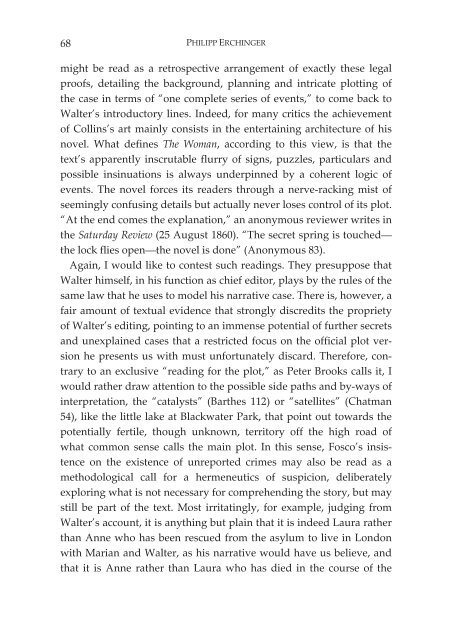Connotations 18.1-3 (2008/2009)
Connotations 18.1-3 (2008/2009)
Connotations 18.1-3 (2008/2009)
Create successful ePaper yourself
Turn your PDF publications into a flip-book with our unique Google optimized e-Paper software.
68<br />
PHILIPP ERCHINGER<br />
might be read as a retrospective arrangement of exactly these legal<br />
proofs, detailing the background, planning and intricate plotting of<br />
the case in terms of “one complete series of events,” to come back to<br />
Walter’s introductory lines. Indeed, for many critics the achievement<br />
of Collins’s art mainly consists in the entertaining architecture of his<br />
novel. What defines The Woman, according to this view, is that the<br />
text’s apparently inscrutable flurry of signs, puzzles, particulars and<br />
possible insinuations is always underpinned by a coherent logic of<br />
events. The novel forces its readers through a nerve-racking mist of<br />
seemingly confusing details but actually never loses control of its plot.<br />
“At the end comes the explanation,” an anonymous reviewer writes in<br />
the Saturday Review (25 August 1860). “The secret spring is touched—<br />
the lock flies open—the novel is done” (Anonymous 83).<br />
Again, I would like to contest such readings. They presuppose that<br />
Walter himself, in his function as chief editor, plays by the rules of the<br />
same law that he uses to model his narrative case. There is, however, a<br />
fair amount of textual evidence that strongly discredits the propriety<br />
of Walter’s editing, pointing to an immense potential of further secrets<br />
and unexplained cases that a restricted focus on the official plot version<br />
he presents us with must unfortunately discard. Therefore, contrary<br />
to an exclusive “reading for the plot,” as Peter Brooks calls it, I<br />
would rather draw attention to the possible side paths and by-ways of<br />
interpretation, the “catalysts” (Barthes 112) or “satellites” (Chatman<br />
54), like the little lake at Blackwater Park, that point out towards the<br />
potentially fertile, though unknown, territory off the high road of<br />
what common sense calls the main plot. In this sense, Fosco’s insistence<br />
on the existence of unreported crimes may also be read as a<br />
methodological call for a hermeneutics of suspicion, deliberately<br />
exploring what is not necessary for comprehending the story, but may<br />
still be part of the text. Most irritatingly, for example, judging from<br />
Walter’s account, it is anything but plain that it is indeed Laura rather<br />
than Anne who has been rescued from the asylum to live in London<br />
with Marian and Walter, as his narrative would have us believe, and<br />
that it is Anne rather than Laura who has died in the course of the

















